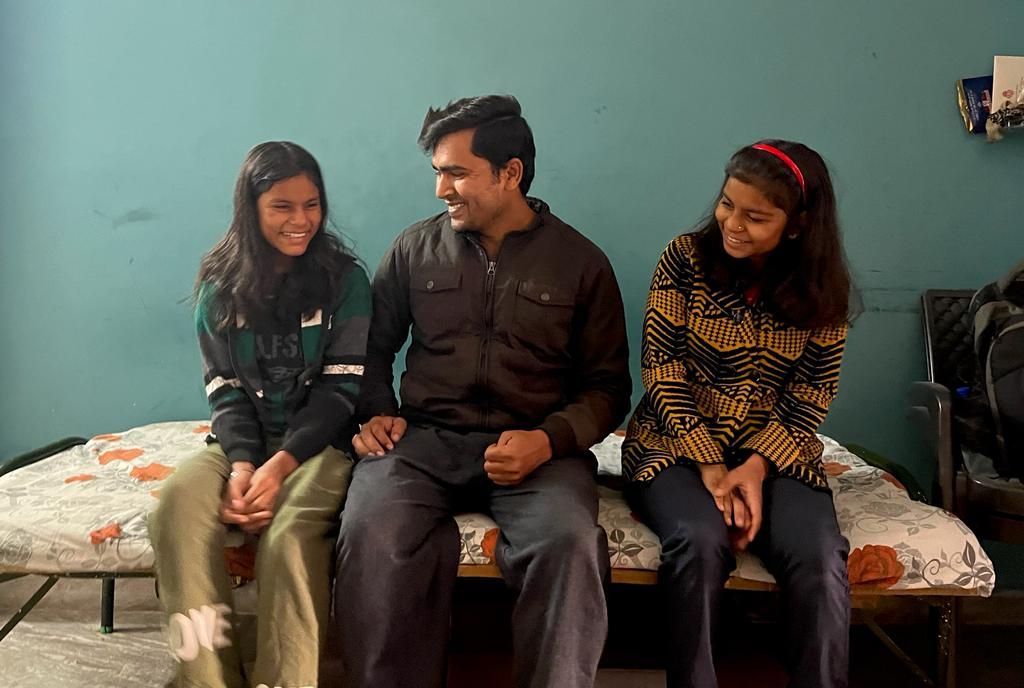Press Release
-

1914 translation by H. Rackham
New Delhi & Pune: Sitting in the corner of a storeroom that he has turned into a home office in Madhu Vihar, an eastern district of India’s capital, Nawab Singh gazed at a wall opposite his wooden desk.
The grey wall was dusty and discoloured: remnants of brown sellotape were stuck all over the grey wall, which had A-4 sized splotches, where papers appeared to have been torn down.
“Jigyasa likes to draw, and I like to put all of them up here,” Singh, 33, explained, slowly looking away. “A few days ago, she tore them up.”
Her hair open, the ends of her loose, green track pants emblazoned with the word “love” in white capital letters, Jigyasa, 11, is Singh’s niece, a quiet and reserved child, the younger of his oldest brother’s two daughters.
Jigyasa, who said she would like to be a doctor, likes to paint, and the splotches on the wall were where she had once stuck her paintings, which she tore down, Singh said, as a result of recurring episodes of anger. He could not explain the outbursts. For the past year and a half, he said, the anger has come and gone.
Jigyasa’s older sister, almost as quiet, with her hair streamlined by a striking red hairband, is Purnima, 13. In April 2021, as a result of a tragedy that unfolded during the Covid-19 pandemic, Singh suddenly found he had become their sole guardian.
"Everything happened in a matter of 96 hours,” said Singh on a chilly December afternoon, his voice hushed. He feared his nieces would hear him and might relive those grim days that he wished for them to forget.
“First their father, and less than two days later, their mother died,” said Singh. “How do you tell two young children that, overnight, they have been orphaned? How do you have these conversations?”
Jigyasa and Purnima’s parents perished as two consecutive waves of the Covid-19 pandemic caused an unprecedented humanitarian crisis nationwide, causing food, hospital beds and oxygen shortages, as the death toll soared to one of the world’s highest, depending on whose data you consider.
Data Disputes, Lives Lost
On 5 May 2022, the World Health Organisation (WHO) estimated 4.7 million Indians had died of Covid-19 over 24 months, between 1 January 2020 and 31 December 2021. That was about 30.9% of the global death toll.
The WHO calculated the lives directly lost to the virus and “excess mortality”—the difference between deaths counted over a specific time period and expected numbers of deaths in the same time period. Within a day of the WHO report, the Indian government objected to the methodology and mathematical models used, stating that no more than 481,000 had died over 28 months, between 3 January 2020 and 6 May 2022. By 23 December 2022, the official government Covid-19 death toll was approximately half a million, with 530,690 fatalities.
There was a similar dispute over statistics of children orphaned by the pandemic in India.
On 24 February 2022, an United Kingdom-based, medical peer-reviewed journal, The Lancet Child & Adolescent Health, recorded over 5.2 million children who lost either one or both of their parents to Covid-19 across 21 nations in the world. The pandemic orphaned as many children in two years as HIV/AIDS did in ten, according to the study.
With the most affected age group ranging from 10 to 17 years old, the Lancet study said the highest rates of children orphaned were in Peru, South Africa, Mexico and India.
India was estimated to have approximately 1.9 million Covid-19 orphans or 36.54% of the global total. The ministry of women and child development on 2 March 2022 disputed this estimate as well in a press release.
Titled “Lancet Article Sophisticated Trickery Intended To Create Panic Among Citizens, Divorced From Truth And Ground Reality”, the ministry provided a state and union territory wise breakdown of children hit by the pandemic, as per the Bal Swaraj portal set-up in May 2021 by the National Commission for Protection of Child Rights (NCPCR).
According to government data, 153,827 children were either orphaned, with a single parent, or abandoned as of 15 February 2022, a number 12 times lesser than the Lancet estimate.
‘Both Children Knew Something Bad Had Happened’
Purnima and Jagyasa were two among 10,386 children, as recorded by government data, to have lost both parents to Covid-19.
“Both children knew something bad had happened,” said Singh. “While Purnima was one of the first people at home to know about their father’s demise, Jigyasa saw their mother struggling to breathe in front of her own eyes.”
Also infected with Covid-19 alongside her parents, Jigyasa was admitted in the same Covid ward as her mother, Snehlata, on 14 April 2021. Her father, Kunwar, was admitted in a ward a floor below them at a government hospital in central Delhi on the same day.
Less than 14 hours later, on April 15, Kunwar—a 39-year-old bookseller and the sole-breadwinner of the family—died.
At approximately 1 am on April 17, Snehlata, six-months pregnant, also died.
Since then, Singh, a newly-registered litigation lawyer, has been trying his best to spend as much time as possible with his nieces in their two-bedroom flat.
“They are both as quiet and talkative as one another,” he said, letting out a small laugh at the sight of Purnima and Jigyasa tip-toeing their way into the room with a tray of warm water.